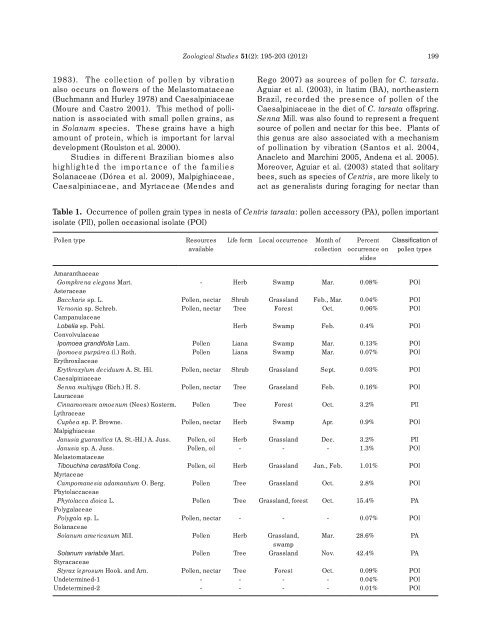Download PDF - Zoological Studies - Academia Sinica
Download PDF - Zoological Studies - Academia Sinica
Download PDF - Zoological Studies - Academia Sinica
You also want an ePaper? Increase the reach of your titles
YUMPU automatically turns print PDFs into web optimized ePapers that Google loves.
<strong>Zoological</strong> <strong>Studies</strong> 51(2): 195-203 (2012)<br />
199<br />
1983). The collection of pollen by vibration<br />
also occurs on flowers of the Melastomataceae<br />
(Buchmann and Hurley 1978) and Caesalpiniaceae<br />
(Moure and Castro 2001). This method of pollination<br />
is associated with small pollen grains, as<br />
in Solanum species. These grains have a high<br />
amount of protein, which is important for larval<br />
development (Roulston et al. 2000).<br />
<strong>Studies</strong> in different Brazilian biomes also<br />
highlighted the importance of the families<br />
Solanaceae (Dórea et al. 2009), Malpighiaceae,<br />
Caesalpiniaceae, and Myrtaceae (Mendes and<br />
Rego 2007) as sources of pollen for C. tarsata.<br />
Aguiar et al. (2003), in Itatim (BA), northeastern<br />
Brazil, recorded the presence of pollen of the<br />
Caesalpiniaceae in the diet of C. tarsata offspring.<br />
Senna Mill. was also found to represent a frequent<br />
source of pollen and nectar for this bee. Plants of<br />
this genus are also associated with a mechanism<br />
of pollination by vibration (Santos et al. 2004,<br />
Anacleto and Marchini 2005, Andena et al. 2005).<br />
Moreover, Aguiar et al. (2003) stated that solitary<br />
bees, such as species of Centris, are more likely to<br />
act as generalists during foraging for nectar than<br />
Table 1. Occurrence of pollen grain types in nests of Centris tarsata: pollen accessory (PA), pollen important<br />
isolate (PII), pollen occasional isolate (POI)<br />
Pollen type<br />
Resources<br />
available<br />
Life form Local occurrence Month of<br />
collection<br />
Percent Classification of<br />
occurrence on pollen types<br />
slides<br />
Amaranthaceae<br />
Gomphrena elegans Mart. - Herb Swamp Mar. 0.08% POI<br />
Asteraceae<br />
Baccharis sp. L. Pollen, nectar Shrub Grassland Feb., Mar. 0.04% POI<br />
Vernonia sp. Schreb. Pollen, nectar Tree Forest Oct. 0.06% POI<br />
Campanulaceae<br />
Lobelia sp. Pohl. Herb Swamp Feb. 0.4% POI<br />
Convolvulaceae<br />
Ipomoea grandifolia Lam. Pollen Liana Swamp Mar. 0.13% POI<br />
Ipomoea purpúrea (l.) Roth. Pollen Liana Swamp Mar. 0.07% POI<br />
Erythroxilaceae<br />
Erythroxylum deciduum A. St. Hil. Pollen, nectar Shrub Grassland Sept. 0.03% POI<br />
Caesalpiniaceae<br />
Senna multijuga (Rich.) H. S. Pollen, nectar Tree Grassland Feb. 0.16% POI<br />
Lauraceae<br />
Cinnamomum amoenum (Nees) Kosterm. Pollen Tree Forest Oct. 3.2% PII<br />
Lythraceae<br />
Cuphea sp. P. Browne. Pollen, nectar Herb Swamp Apr. 0.9% POI<br />
Malpighiaceae<br />
Janusia guaranítica (A. St.-Hil.) A. Juss. Pollen, oil Herb Grassland Dec. 3.2% PII<br />
Janusia sp. A. Juss. Pollen, oil - - - 1.3% POI<br />
Melastomataceae<br />
Tibouchina cerastifolia Cong. Pollen, oil Herb Grassland Jan., Feb. 1.01% POI<br />
Myrtaceae<br />
Campomanesia adamantium O. Berg. Pollen Tree Grassland Oct. 2.8% POI<br />
Phytolaccaceae<br />
Phytolacca dioica L. Pollen Tree Grassland, forest Oct. 15.4% PA<br />
Polygalaceae<br />
Polygala sp. L. Pollen, nectar - - - 0.07% POI<br />
Solanaceae<br />
Solanum americanum Mill. Pollen Herb Grassland, Mar. 28.6% PA<br />
swamp<br />
Solanum variabile Mart. Pollen Tree Grassland Nov. 42.4% PA<br />
Styracaceae<br />
Styrax leprosum Hook. and Arn. Pollen, nectar Tree Forest Oct. 0.09% POI<br />
Undetermined-1 - - - - 0.04% POI<br />
Undetermined-2 - - - - 0.01% POI

















